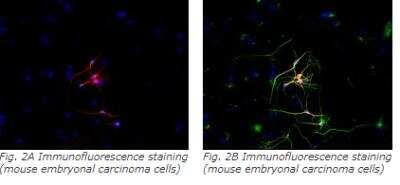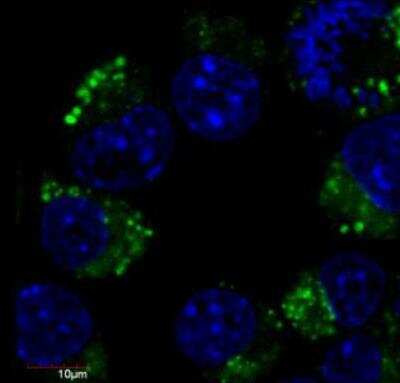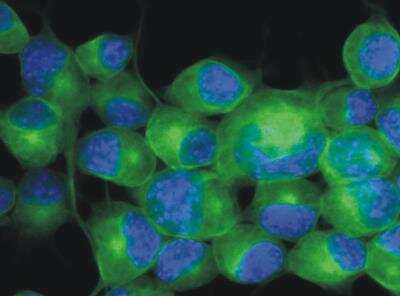beta-III Tubulin Antibody (TU-20) [FITC]
Novus Biologicals, part of Bio-Techne | Catalog # NB500-620


Conjugate
Catalog #
Forumulation
Catalog #
Key Product Details
Species Reactivity
Human, Mouse, Rat, Canine
Applications
Flow (Intracellular), Flow Cytometry, Immunocytochemistry/ Immunofluorescence, Immunohistochemistry, Immunohistochemistry-Paraffin, Western Blot
Label
FITC (Excitation = 495 nm, Emission = 519 nm)
Antibody Source
Monoclonal Mouse IgG1 Clone # TU-20
Concentration
1.0 mg/ml
Product Specifications
Immunogen
Peptide (C) 441-448 coupled to maleimide-activated keyhole limpet hemocyanin via cysteine added to the N-terminus of the neuron-specific peptide.
Reactivity Notes
Please note that this antibody is reactive to Mouse and derived from the same host, Mouse. Mouse-On-Mouse blocking reagent may be needed for IHC and ICC experiments to reduce high background signal. You can find these reagents under catalog numbers PK-2200-NB and MP-2400-NB. Please contact Technical Support if you have any questions. Rat reactivity reported in scientific literature (PMID: 23984759).
Specificity
The antibody TU-20 recognizes C-terminal peptide sequence ESESQGPK (aa 441-448) of neuron-specific human betaIII-tubulin.
Marker
Neuronal Marker
Clonality
Monoclonal
Host
Mouse
Isotype
IgG1
Scientific Data Images for beta-III Tubulin Antibody (TU-20) [FITC]
Immunocytochemistry/Immunofluorescence: beta-III Tubulin Antibody (TU-20) [FITC] [NB500-620] - Immunofluorescence staining of P-19 mouse embryonal carcinoma cell line stimulated to neuronal differentiation by retinoic acid. 2A - Microtubules decorated with neuron-specific anti-betaIII-tubulin (TU-20; red). 2B - Merged image of co-staining with anti-beta-tubulin (TU-06; green). Superposition of red and green colours provided yellow staining. Nuclei were stained with DNA-binding dye (blue).
Immunocytochemistry/Immunofluorescence: beta-III Tubulin Antibody (TU-20) [FITC] [NB500-620] - Immunofluorescence staining of Neuro2a mouse neuroblastoma cell line using anti-betaIII-tubulin (TU-20 FITC, green, 1 ug/ml). Nuclei were stained with DAPI (blue).
Immunocytochemistry/Immunofluorescence: beta-III Tubulin Antibody (TU-20) [FITC] [NB500-620] - Staining of Neuro2a mouse neuroblastoma cell line using anti-betaIII-tubulin (TU-20; green; 3 ug/ml). Nuclei were stained with DAPI (blue).
Applications for beta-III Tubulin Antibody (TU-20) [FITC]
Application
Recommended Usage
Flow (Intracellular)
1-3 ug/ml
Flow Cytometry
1-3 ug/ml
Immunocytochemistry/ Immunofluorescence
1:400
Immunohistochemistry
1:10-1:500
Immunohistochemistry-Paraffin
10 ug/ml
Western Blot
1-2 ug/ml
Application Notes
For Immunohistochemistry-Paraffin: Use standard ABC technique (DAB+). Purity is > 95% (by SDS-PAGE). Western Blot: reducing conditions
Formulation, Preparation, and Storage
Purification
Size Exclusion Chromatography
Formulation
PBS (pH 7.4)
Preservative
0.09% Sodium Azide
Concentration
1.0 mg/ml
Shipping
The product is shipped with polar packs. Upon receipt, store it immediately at the temperature recommended below.
Stability & Storage
Store at 4C in the dark.
Background: beta-III Tubulin
Alternate Names
beta-Tubulin III, Beta3-tubulin, betaIII Tubulin, Class III beta-tubulin, TUBB3, Tubulin Beta 3, Tubulin beta-4, Tubulin beta-III
Gene Symbol
TUBB3
Additional beta-III Tubulin Products
Product Documents for beta-III Tubulin Antibody (TU-20) [FITC]
Product Specific Notices for beta-III Tubulin Antibody (TU-20) [FITC]
This product is for research use only and is not approved for use in humans or in clinical diagnosis. Primary Antibodies are guaranteed for 1 year from date of receipt.
